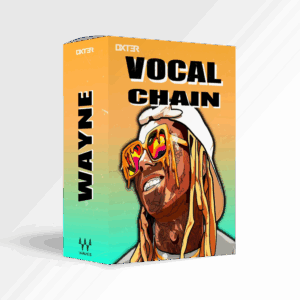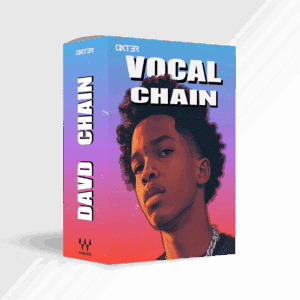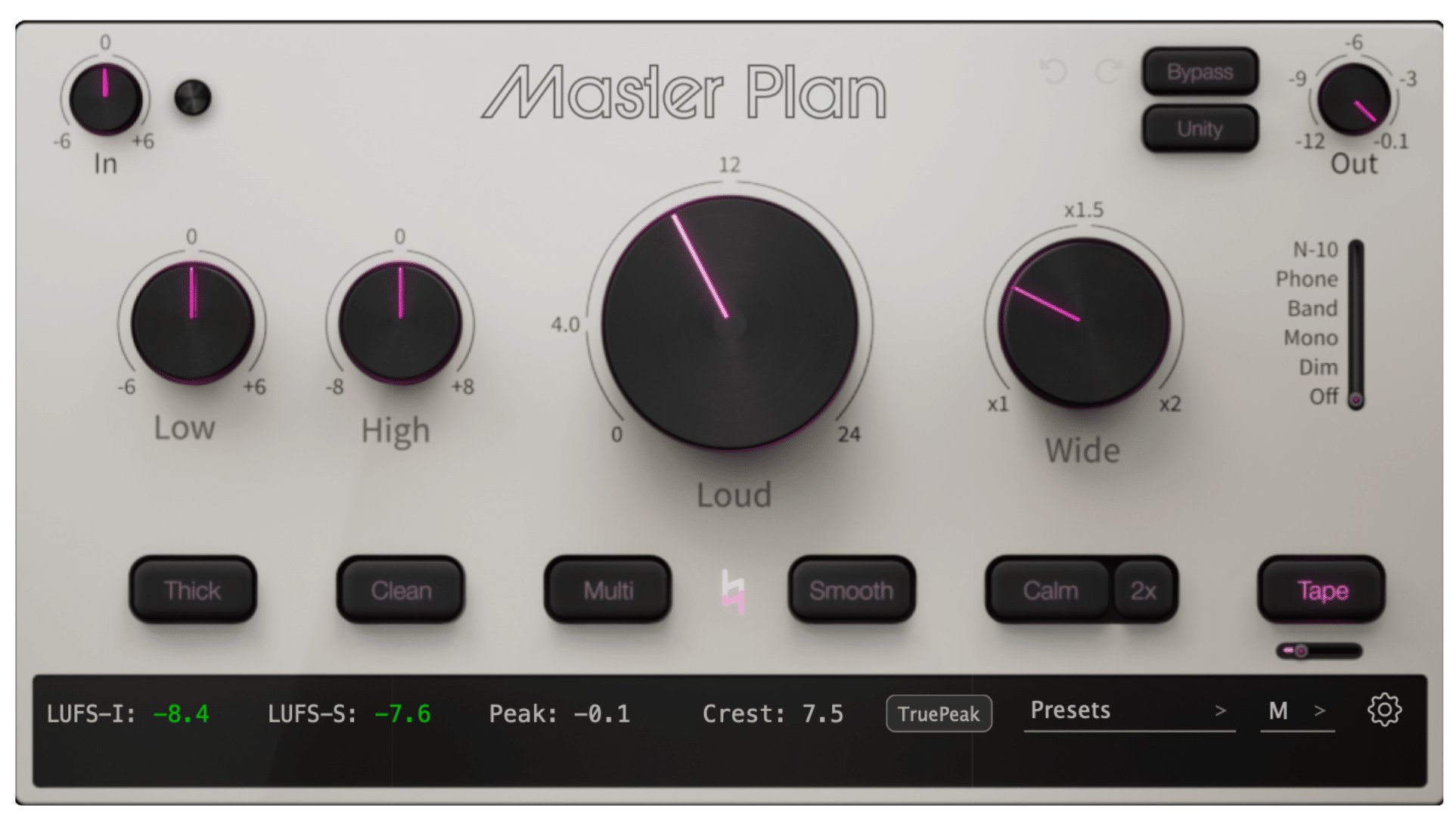
Share This Post
Get ready to master any mix with Musik Hack Master Plan! It’s not just about cranking up the volume.
In this extensive review, we’ll delve into the intricacies of Master Plan, exploring its impressive features, user-friendly interface, and determining whether it’s the missing element that will unlock the full potential of your music. Join us as we uncover the truth behind Musik Hack’s Master Plan: Hyped or The Real Deal in Mastering Plugins?
In this mega audio plugin review, we’re going to unravel the mysteries of Master Plan, checking out its cool features, how easy it is to use, and whether it’s the secret audio mastering sauce your music’s been missing.
Musik Hack Master Plan's Features and Compatibility:
Master Plan works on both Mac and Windows in all DAW. Choose from flexible subscription plans – opt for a twelve-month term or make a long-term commitment with a perpetual license. The registration process is streamlined, and once you’re onboard, you are no longer bound by the necessity of an internet connection.
Musik Hack's Master Plan User Experience:
Our audio expert, Dxt3r (@dxt3r_Lab), approached Musik Hack’s Master Plan with measured caution. Traditional processors are like a trusted pair of studio slippers—reliable, broken-in, and predictable. Stepping into Master Plan felt like slipping on a sleek, unfamiliar racer: exciting, but uncharted.
The novelty, however, never translates to discomfort.
The star of the show is the ‘Loud’ knob, but its real magic unfolds with restraint. Dial it back, and Master Plan reveals itself as a surgical maximizer, powered by a limiter/clipper algorithm that’s equal parts transparent and ruthless. It doesn’t just push levels—it sculpts them.
Visually, the plugin is a playground. The interface resizes effortlessly, letting you tailor the workspace. Default dark mode (black canvas, off-white text) not your vibe? Flip to a clean white background in one click.
The dynamic colored ‘glow’ pulsing around the controls? Pure disco for your DAW. Love the flair? Keep it. Prefer stealth mode? Toggle it off in settings and pick your own LED hue.
Master Plan doesn’t demand you adapt—it adapts to you.
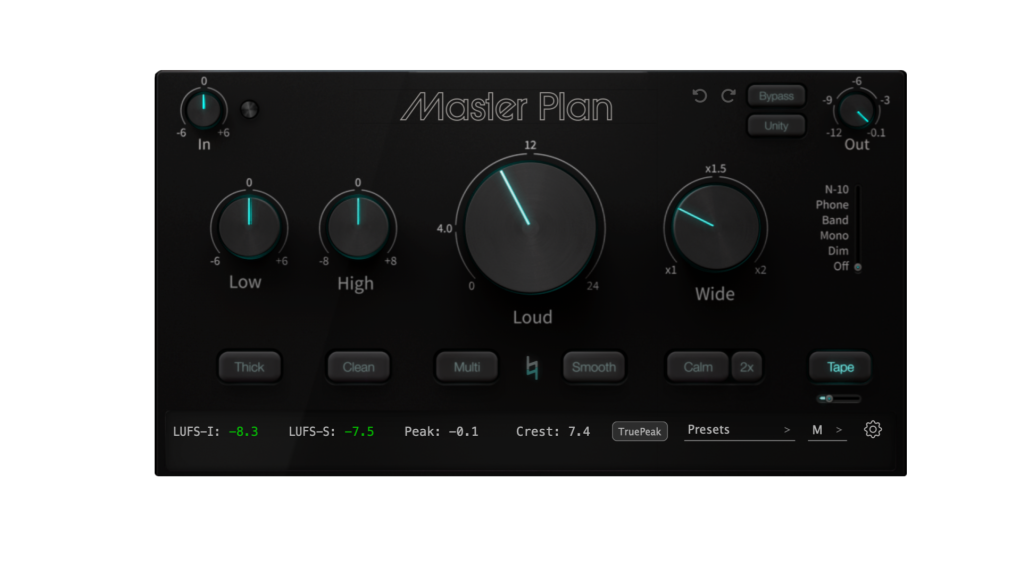
Musik Hack Master Plan Functionality:
Before you start twiddling knobs, listen to the default settings. There’s a subtle thickness and a presence boost (fancy words for making things sound cooler). Master Plan isn’t just about making things loud; it’s like a magic wand for your audio, balancing and sweetening the mix. The minimal controls mean it can’t do everything, but what it does, it does with style.
Diving Deeper in Master Plan:
Multi processor: Picture it like a superhero cape for your audio. The Multiband Processor swoops in, adjusting frequencies dynamically based on the signal. It’s like having a frequency wizard in your corner, fixing imbalances and making your music shine.
Saturation and Harmonic Exciter “Thick”: Think of it as adding spice to your audio recipe. Master Plan’s saturation and harmonic exciter bring warmth and character, giving your music that analog vibe. And the Harmonic Exciter? It’s like a spice rack for harmonics – sprinkle in some energy!
Stereo Widening and Imaging “Wide”: Time to make your music three-dimensional! The Stereo Widening and Imaging tools let you paint a sonic masterpiece. From a subtle spread to an expansive landscape, you’re in control of how wide your sound goes.
- Tape Emulation:The Tape knob on the Master Plan adds a layer of tape emulation, giving your sound the warm, vintage character of analog recordings. It introduces subtle but noticeable tape saturation that enhances the richness and depth of your audio. By adjusting this knob, you can blend in just the right amount of analog warmth, creating a nuanced sonic texture reminiscent of classic tape-based productions.
(The Master Plan team Sam and Stan shared with me that they dedicated substantial effort to perfecting the Tape knob, making it one of my favorite features due to its ability to evoke a warm and nostalgic tape emulation in the audio processing.)
Master Plan Customization and GUI Fun:
Master Plan is like your favorite LEGO set – you can make it your own. Resize the GUI to fit your style, from pocket-sized to wall-sized. The black background is sleek, but if it’s not your vibe, switch to white. And those glowing controls? If it’s too much like a disco ball, turn it off and pick your favorite LED color. Master Plan is all about making your experience personal.
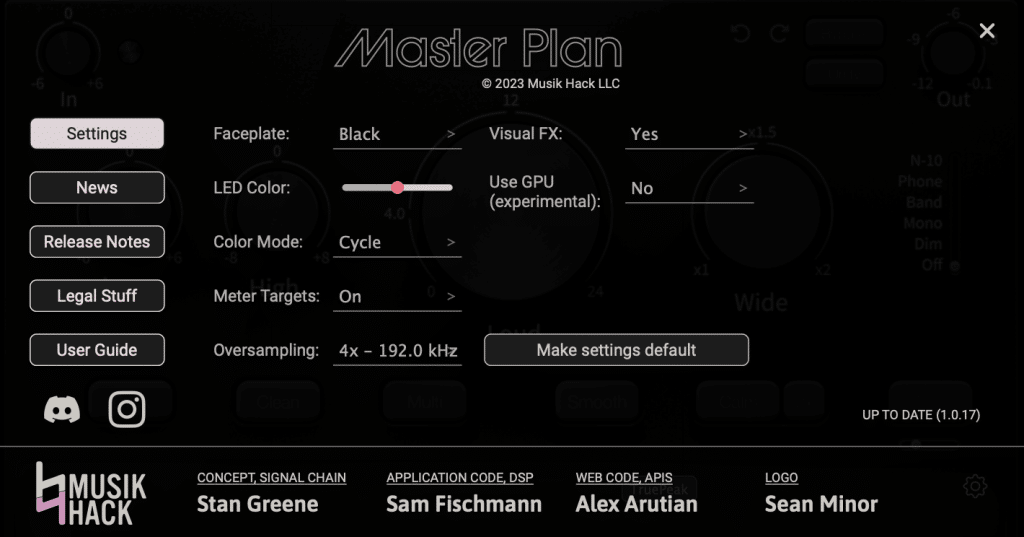
Putting Musik Hack Master Plan into Action:
Let’s get hands-on.
At its core, Master Plan is a transparent loudness processor. Everything revolves around the central Loud knob—this sets how hard the limiter/clipper hits. Push it, and you’re in maximum loudness territory. Ease off, and it becomes a precision maximizer.
Tone Shaping: Two-Band EQ
- Low (±6 dB) – Gentle shelf for warmth or control.
- High (±8 dB) – Airy top-end sculpting with extra range.
Then come the smart one-click fixes:
- Clean – Cuts low-end mud without surgery.
- Calm – Tames harsh highs before they bite.
Flavor on Demand
Want character? Flip into saturation:
- Tape – Instant vintage warmth, fixed but musical.
- Thick – Analogue-style body, no knobs needed.
Multi-Band Compression
Hit Multi, and three fixed bands (low, mid, high) come alive. Use the sliders to dial in gain reduction per band.
- Add Smooth to gently ride dynamics—like a soft hand on the fader.
Stereo Width
One knob does it all: Wide. Phase-coherent stereo enhancement that expands your mix without phase issues. Subtle or cinematic—your call.
Pro Monitoring Built In
- Mono sum – Check compatibility.
- Dim – Quick level reference.
- NS10 & Phone emulations – Hear it like your audience will.
At the bottom: precision metering → Short-term & Integrated LUFS → Peak & Crest readouts
From Orchestra to 808s: Real-World Wins
Classical / Orchestral Multi Processor carves space between strings and brass. Clean removes rumble, Wide opens the hall, and subtle Loud glues it all—transparent, detailed, emotional.
Hip-Hop / Pop Crank Thick for chest-punching low-end. Tape adds grit to drums. Multi + Smooth tames transients without killing snap. Wide makes the hook surround the listener. Final Loud push? Radio-ready, every time.
Master Plan isn’t just a plugin—it’s a mastering co-pilot. One interface. Zero clutter. Total control.
Whether you’re polishing a symphony or slamming a trap beat, it adapts, enhances, and elevates.
Musik Hack Master Plan: Loudness without compromise. Character without chaos.
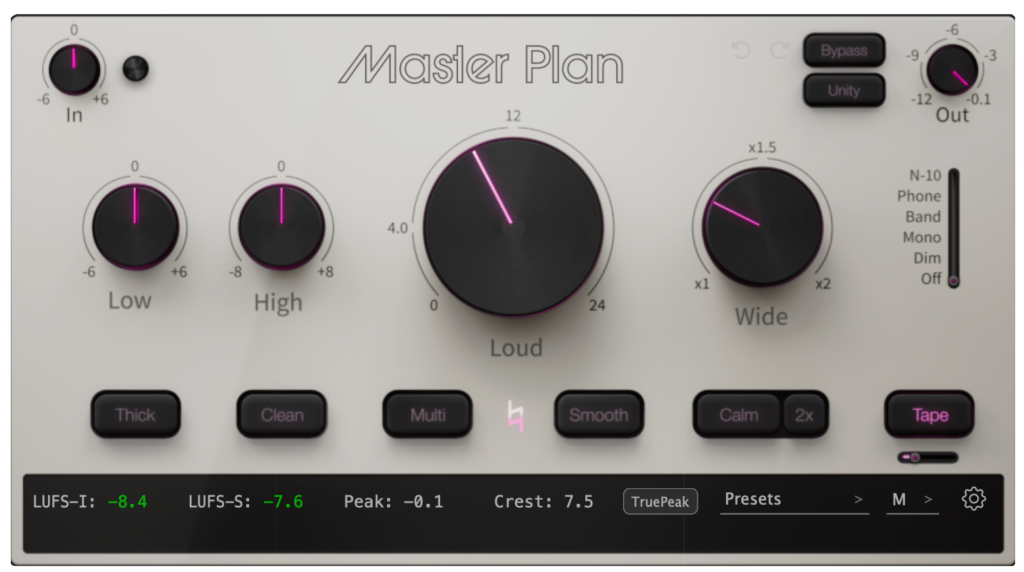
Pricing & Availability
Master Plan is available now, with rent-to-own and permanent licences currently being offered for reduced introductory prices. Rent-to-own 35$ x5 month, and a permanent costs $87.50 (usually $175).
Musik Hack Master Plan Compatibility
Master Plan is supported on Mac and Windows platforms, and is available in VST3, AU and AAX plug-in formats. compatible with all DAW.
Addressing the Hurdles:
Master Plan is fantastic, but let’s be real – no superhero is perfect. The minimal controls might leave tech-savvy mastering engineers wanting more buttons to push. And yes, there are no fancy meters. But hey, Master Plan is like a focused mastering superhero – it does what it’s meant to do exceptionally well.
Conclusion: Musik Hack Master Plan
In the grand showdown of mastering processors, Master Plan by Musik Hack is like the cool kid who’s secretly an audio mastering superhero. It’s not just about loudness; it’s about shaping and enhancing your music with style. Is it replacing your entire studio? Probably not. But is it a fantastic maximizer, making your tunes sound awesome? Absolutely! Master Plan invites you into its sonic playground, ready to turn your musical journey into a thrilling adventure. So, what are you waiting for? Let the audio magic begin!
More To Explore
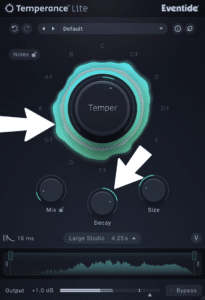
Eventide Temperance Lite Review: Gem or Just Hype?
Share This Post Eventide released Eventide Temperance Lite, a reverb that introduces something pretty unconventional: modal reverb shaping combined with musical “tempering.” After spending time
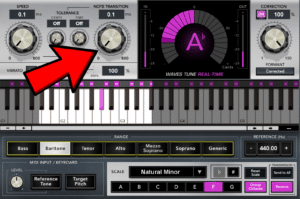
Waves Tune Real-Time Review – Still Worth Using in 2026?
Share This Post I’ve been using Waves Tune Real-Time on and off for years, and after putting it through plenty of vocal sessions recently, I
